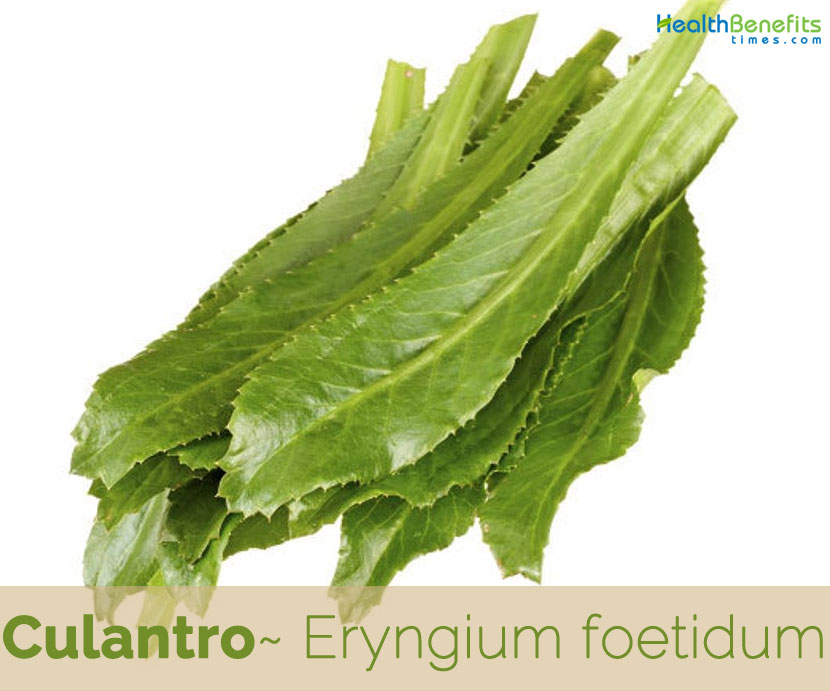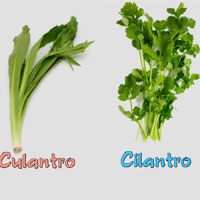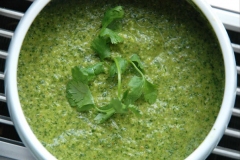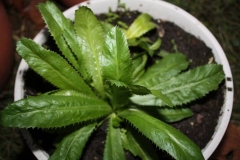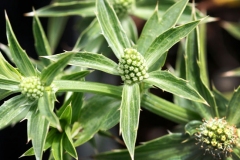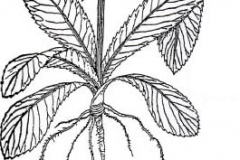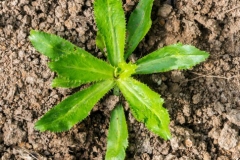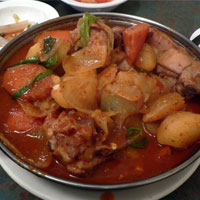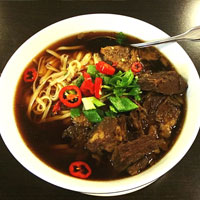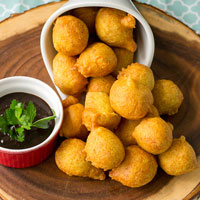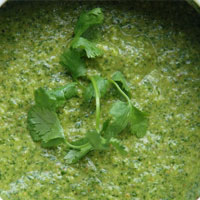| Culantro Quick Facts | ||
|---|---|---|
| Name: | Culantro | |
| Scientific Name: | Eryngium foetidum | |
| Origin | Central and South America, from southern Mexico to Panama, Colombia, Bolivia and Brazil and from Cuba to Trinidad | |
| Shapes | Egg-shaped schizocarp, up to 1.5 mm × 0.75 mm, densely tuberculate | |
| Taste | Bitter, soapy flavor similar to cilantro, but stronger | |
| Health benefits | Eliminate Bad Breath, Lowers Glucose, Asthma, Pain Relief, Prevents Neurological inflammation, Detoxification | |
| Plant Part | Method of Preparation | Use |
|
Leaf |
Infusion | Fever, flu, diabetes, hypertension, constipation diuretic, anti-convulsant |
| Bath | Colds, heat, muscular pain | |
| Decoction or Tincture sometime with Lemon | Diarrhea, stomach ache, cold, Fever, flu, gas, nausea, malaria, leishmaniasis | |
| Decoctions or Infusions | Snake bite, aire, abdominal pain, postpartum abdominal pain, fever, digestive ailments, vaginal infections | |
| Decoction | Hypertension, colds, fevers | |
| Concoction mixed with Milk | Stomach ache, asthma | |
| Tincture rub | Rheumatism, emmenagogue | |
| Leaves, roots and fruits are crushed and taken | Indigestion | |
| Juice | Anti convulsant | |
| Plaster | Abscess, boils | |
| Unspecified | Geniturinary disturbances | |
|
Whole plant |
Unspecified | Colds, flu, diarrhea, childbirth complications, infertility, menstrual pain, unspecified female complications, poisoning, gastritis, fever, snakebites |
| Boiled or toasted and massaged | Eye Disease | |
| Boiled with castor oil | Biliousness, constipation, fits yellow fever | |
| Decoctions | Fever, flu, chills, gout, condiment, ease delivery, VD | |
| Juice | Remove parasites, infection, itching | |
|
Aerial Parts |
Decoctions | Earache, chest pains, fevers hypertension, fits, convulsions gastrointestinal problems |
| Topical application of Paste | Headache | |
| Unspecified | Abortion induction, sexual dysfunction, diarrhea, fever, headaches | |
|
Roots |
Infusion | Vermifuge |
| Infusion in rum or wine tincture | Worm infections | |
| Topical application of paste | Headache | |
| Seeds | Topical application of paste | Headaches, cure madness |
|
Unspecified |
Unspecified | Aphrodisiac, emmenogogue, abortifacient, convulsions, fits |
| Drink or Massage | Febrifuge, sudorific |
Traditional uses and benefits of Culantro
- Root decoction is taken as a sudorific, diuretic, febrifuge, abortifacient, stomachic and stimulant.
- Juice or a decoction of the leaves is used as a stimulant, as a laxative and as a remedy for colds and fever.
- Decoction of the whole plant is said to lower blood pressure, to be a potent emmenogogue and abortifacient, and is also used as an aphrodisiac.
- Decoction of the whole plant is used as an anti-malarial and for the treatment of hemorrhages.
- Plant is boiled and the water used for a herbal bath or as a medication for chicken pox and measles.
- The leaves are febrifuge, laxative.
- An infusion is used to treat chills, grippe, fevers, head colds, as a children’s purgative.
- Decoction of the crushed leaves is used as a treatment for children’s leprosy and children’s convulsions.
- An infusion is used to treat hydropsy and stomach pains.
- Leaf shows antimicrobial activity.
- It is reportedly used in traditional medicine for burns, earache, fevers, hypertension, constipation, fits, asthma, stomachache, worms, infertility complications, snake bites and also in malaria.
- Tea prepared from the leaves is used to treat fever, flu, diarrhea, constipation, and vomiting.
- It is also thought to promote menstrual bleeding.
- Plant is used in traditional medicines for fevers and chills, vomiting, diarrhea and in Jamaica for colds and convulsions in children.
- Leaves and roots are boiled and the water drunk for pneumonia, flu, diabetes, constipation, and malaria fever.
- Root can be eaten raw for scorpion stings and in India the root is reportedly used to alleviate stomach pains.
- Leaves themselves can be eaten in the form of chutney as an appetite stimulant.
- Decoction of whole plants used as antimalarial.
- In Mizoram, India, decoction of fruits used in dysentery.
- Leaf juice applied to forehead for fever.
- Ethnic communities in the Kodagu district of Karnatak use the leaf decoction against gastrointestinal disorders and the leaf paste for wound healing.
- It can also help with asthma, it lowers the blood pressure, and it helps with epileptic seizures.
- It has a calming effect and it soothes away the seizures.
- It also soothes away the headaches when you drink its tea.
- Leaves and roots are boiled and the water drunk for treating pneumonia, flu, diabetes, constipation, and malaria fever.
- Crushed leaves are placed in the ear to treat pain, and are used for the local treatment of arthritic processes.
- Plant is useful for female reproductive problems such as infertility, childbirth complications, menstrual pains, ease of delivery, postpartum abdominal pains, and vaginal infections and as an emmenogogue.
- Decoction of the whole plant is used to ease delivery, but is contraindicated for pregnancy because it is reported to provoke uterine contraction in Brazil.
Culinary uses
- Fresh leaves are used as a flavoring in food, e.g. in soups, curries, stews, rice and fish dishes.
- Tender young leaves are eaten raw or cooked, as a vegetable.
- Aromatic herb is used to increase taste in various curries.
- It is also used to add in chutneys, torka etc. for its attractive flavor and taste.
- Leaves can be steamed and served with rice.
- Root is used as a flavoring in soups.
- Seed is used as a flavoring.
- Leaves are used to season meat and other foods in Caribbean, Latin American and Asian cuisines.
- In Latin America, the leaves are often added to salsas, a spicy, tomato-based sauce that is eaten with tortilla chips.)
- Cilantro leaves can be used to prepare a variety salsas, gravies, barbecued foods and even appetizing drinks.
- Fresh leaves can be used in salad.
Recipes
Braised Chicken Stew Recipe
Ingredients
- 2 1/2 pounds chicken (with skin on, thighs, legs, breast, and wings, cut-up)
- 1/2 to 1 teaspoon adobo seasoning
- 1 tablespoon olive oil (extra virgin)
- 1/2 cup sofrito
- 1 packet sazón seasoning (or 1 tablespoon annatto/achiote oil)
- 1/4 cup olives (pimento-stuffed Spanish Manzanilla, pitted)
- 1 teaspoon ground cumin
- 1 bay leaf
- Optional: 1 culantro leaf (or recao leaf)
- Optional: 1/2 teaspoon Italian seasoning
- 8 ounces tomato sauce (canned, seasoned with peppers and onions)
- 1 cup chicken broth (or water)
- 1 large potato (cut into bite-sized cubes)
- Garish: cilantro (chopped)
- Garnish: parsley (chopped)
Direction
- Gather the ingredients.
- Season the chicken pieces with the adobo seasoning.
- Heat the olive oil over medium heat in a heavy skillet or a Dutch oven. Make sure you have a lid available to cover it tightly.
- Add the chicken pieces and brown them on each side, about 5 minutes per side.
- Add the sofrito, the sazón packet, Spanish olives, cumin, bay leaf, culantro, Italian seasoning, tomato sauce, chicken broth, and potato cubes. Turn the chicken pieces to coat them with the sauce.
- Cover the pot with a tight-fitting lid and reduce the heat to low. Simmer the chicken stew for 35 minutes or until the chicken is done.
- Remove the bay leaf and the cilantro leaf.
- Garnish the chicken pieces with fresh chopped cilantro or parsley and serve the sauce over your favorite rice recipe.
Vietnamese Beef Noodle Soup
Ingredients
For Beef Broth
- 1 small onion (chopped)
- 1 2-inch stick ginger
- 2 pounds beef bones
- 12 cups water
- 6 star anise
- 1 teaspoon salt
- 1 teaspoon sugar
- 1 pound beef (lean and tender)
For Noodles
- 1 16-ounce package flat rice noodles (pho)
For Garnish
- 3 scallions (thinly sliced)
- 1 large onion (thinly sliced)
- 10 Cilantro sprigs (finely chopped)
- 1 cup bean sprouts
- 10 sprigs basil
- 10 sprigs fresh culantro
- 1 fresh red or green chile pepper (thinly sliced)
- Garnish: lime or lemon quarters
- Garnish: fish sauce
- Garnish: hoisin sauce
- Garnish: hot chile sauce
Directions
- Broil onion and ginger until they look burned. Using the back of a cleaver, smash the ginger and set aside.
- Wash beef bones, place in a large soup pot and add water to cover. Bring to a boil and immediately pour off this “first boiling” water and discard. Add another 12 cups of fresh water and again bring to a boil. Skim off foam.
- Add the broiled onion and ginger, star anise, salt, and sugar. Over medium-low heat, simmer for 30 minutes. Slice raw beef into thin strips and set aside.
- Remove bones from broth and strain out vegetables and seasonings.
- Soak noodles in cold water for 10 minutes. Drain. In a soup pot bring two quarts fresh water to a boil. Add drained noodles and cook seven minutes at a rolling boil, stirring occasionally until noodles are tender.
- Rinse noodles under cold running water and set aside.
- Return the broth to a boil over high heat.
- Divide noodles among 4 to 6 large individual serving bowls. Arrange thinly sliced raw beef, scallions, onion, and cilantro on top. Pour boiling hot broth to cover noodles and serve immediately. The boiling broth will cook the thin slices of beef.
- Pho is always accompanied by bean sprouts, basil leaves, cilantro, and chile pepper. Serve with lime and lemon quarters, fish sauce, hoisin sauce, and hot chile sauce.
Pholourie
Ingredients
- 1 lb flour
- 1/2 tsp saffron
- 1 tsp yeast
- 1 tsp salt
- 1/2 tsp baking powder
- 11/2 tsp brown sugar
- 10 culantro (chadon beni) leaves
- 5 small garlic cloves
- 1 small hot pepper
- About 2 cups warm water
- Oil for frying
Directions
- Combine first six ingredients in a large mixing bowl.
- In a blender or food processor, mince culantro leaves, garlic and hot pepper in some of the warm water.
- Gradually add this mixture to the dry ingredients while vigorously mixing with a fork.
- Continue to add remaining warm water and mixing until a smooth batter is formed. (Tip: you can use the water to “rinse” the emptied processor or blender to ensure you get as much seasoning in the mixture).
- Cover with damp paper towels or kitchen towels and let rest for one to two hours, until more than doubled in size.
- Heat oil in large, heavy bottomed pot over medium heat until hot but not smoking.
- Use half tablespoon or tablespoon (depending on what size you want your pholourie balls to be) and scoop batter into the pot. You can use another spoon to help shape batter and get it into the pot more easily. Before scooping, dip spoons into a cup of water or oil to get batter into the pot more easily.
- Move balls back and forth to ensure even frying. Lower heat if, balls are getting brown too quickly.
- When they feel light and are a light golden brown, remove from heat and place on paper towels. Break one to ensure it cooks through.
- Repeat process for the remaining batter. Serve warm with favourite chutney.
Culantro Pesto
Ingredients
- 2 garlic cloves
- 1/2 teaspoon salt, plus more to taste
- Freshly ground black pepper
- 2 tablespoons pine nuts
- 2 tablespoons olive oil
- 1 cup packed fresh culantro leaves
- 1/3 cup grated Parmesan and/or Pecorino Romano cheese
Directions
- Combine the garlic, salt, pepper to taste, and pine nuts in a food processor.
- Add the oil and culantro and process until smooth.
- Add the cheese and pulse to incorporate.
- Store in an airtight container until ready to use, up to 1 week in the refrigerator or 4 months in the freezer.
Other facts
- In Java, the plant is fed to cattle as fodder.
- Fragrance emitted from the leaves is somewhat like crushed bedbug.
- Flavor of Culantro is diminished after it flowers; so leaves are typically harvested before the plant develops its flower stems.
- An essential oil can be distilled from the seed.
References:
https://www.itis.gov/servlet/SingleRpt/SingleRpt?search_topic=TSN&search_value=29507#null
https://davesgarden.com/guides/pf/go/94023/
http://www.hear.org/pier/species/eryngium_foetidum.htm
https://npgsweb.ars-grin.gov/gringlobal/taxonomydetail.aspx?id=15716
https://plants.usda.gov/core/profile?symbol=ERFO5
http://www.theplantlist.org/tpl1.1/record/kew-2799284
https://uses.plantnet-project.org/en/Eryngium_foetidum_(PROSEA)
https://indiabiodiversity.org/species/show/229639
https://florafaunaweb.nparks.gov.sg/Special-Pages/plant-detail.aspx?id=4850
https://gd.eppo.int/taxon/ERXFO
https://hort.purdue.edu/newcrop/proceedings1999/v4-506.html
http://www.flowersofindia.net/catalog/slides/Long%20Coriander.html


